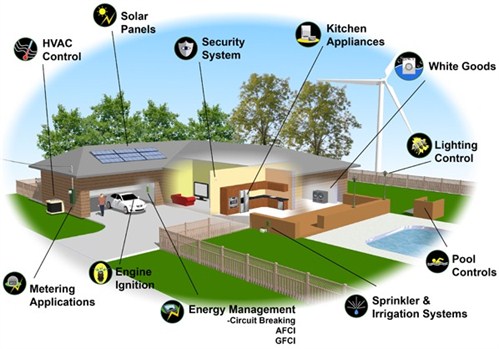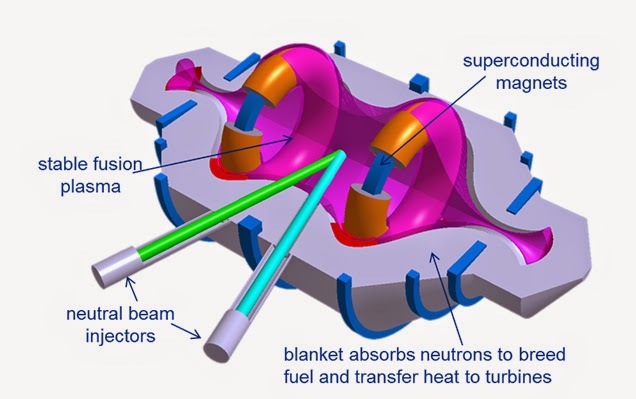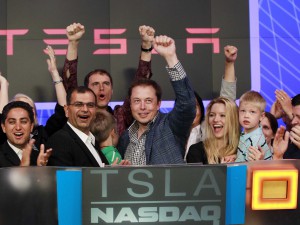Disruptive Innovation
Where is the Killer App for “The Connected Home”?

The “Connected Home”, a concept we talked about in class as part of the disruptive innovation section, currently has a low household penetration rate. According to this article on USAToday, NextMarket Insights reports that only 1.48 million American households had smart home systems by the beginning of 2014; this number, however, is projected to skyrocket to 15.03 households by 2019.As innovative as the idea is, not many Americans are aware of the concept and the technologies that currently back it. Apple, Samsung, Nest, and Google are among a slew of companies releasing dedicated technologies aiming to connect the home through “The Internet of Things” (and debuted many of these at this year’s CES conference, such as Apple’s HomeKit and Samsung’s SmartThings platform), but herein lies the problem: there is no standard method of connecting household appliances. Each company offers their own proprietary solutions, which doesn’t help when mixing and matching appliances and technologies; in other words, the different components of a connected home won’t necessarily be compatible with each other.
In order for these technologies to truly disrupt the market and gain a widespread adoption rate, many feel the need for a “Killer App“ to sway the majority of consumers into investing into the technology: one that is easy to use and provides a high level of standardization.
- What components do you guys think will be required in a “killer app” for a Connected Home, and who do you think is capable of pulling this off?
- Is there any established technology out there, such as Apple’s HomeKit (which allows hands-free Siri communication), that you think will eventually dominate the market?
- What is still missing in this sector that consumers have a need for that isn’t being provided?
- Lastly, do you agree with the household penetration projection for 2019?
Lockheed Martin’s Claims Sustainable Fusion is Within Its Grasp

Lockheed Martin Claims Sustainable Fusion is Within Its Grasp
Skunk Works Reveals Compact Fusion Reactor Details
Lockheed Martin’s New Compact Fusion Reactor Might Change Humanity Forever
In February, Lockheed Martin’s Skunk Works team made a bold announcement: they are 5-10 years away from successfully creating and commercially selling compact fusion reactors (CFRs). These devices are conceptually safer, cleaner, and more powerful than much larger nuclear systems that rely on nuclear fission. CFRs use water for fuel, produce byproducts that are safe, and releases no air pollution. These devices are scalable, so they can be used as the power source for airplanes and space ships, for which they could fly indefinitely. A CFR that is the size of 23 x 42 feet could produce enough energy to power a large cargo ship or an 80,000-home city. If Lockheed Martin can actually make this work, then, as so many people are saying, it will be a revolutionary and transformative step for humanity.
It’s clear that such a device would be a huge disruptive innovation. To create a cheap, portable, more powerful, safe and clean energy source would significantly affect several industries, especially the energy, oil and gas, and environmental industries. I think would be several types of disruptive innovations, including low-end, sustaining, and new-market innovation. This would be a low-end innovation because using a CFR would be cheaper than using, say, oil and gas for your primary energy source. It would also reduce the risk of catastrophic nuclear disasters (think Fukushima). This would be a new-market innovation because, well, a fusion reactor has never been created before. It may be performing the same function as other energy sources, but it will create new industries around it. And it will be a sustaining innovation for the reason mentioned earlier: it’s performing the same function of generating energy.
What do you guys think about these Lockheed Martin’s announcement? Is it as revolutionary as they purport it to be, or is it overhyped? Do you think it would be a major disruptive innovator, or might it lose out to legal opposition from the current energy and oil and gas industries? What other industries do you think would be affected by this technology? Let me know what you think!
Is Tesla on The Brink of Disruptive Innovation?
http://abcnews.go.com/Technology/tesla-technology-produce-cars/story?id=30025690
Tesla Motors announced on Monday that they are introducing a new product, but to much dismay it is not a new car. Tesla was creating something new, keeping all consumers in the dark.
“We need the ability to store energy when it’s bountiful and use it when it isn’t bountiful,” Brauer said. “If somebody can come up with a system to time shift energy storage, that would have a lot of potential and go far beyond the automotive industry.”
Rumors are divulging from this comment from a senior analyst at Kelley Blue Book, that it may be some type of home battery.
What types of innovative creations could Tesla have up it’s sleeve?
Tesla’s New Venture — Home Batteries?

Tesla CEO Elon Musk tweeted today “Major new Tesla product line — not a car — will be unveiled at our Hawthorne Design Studio on Thurs 8pm, April 30″ and these few simple words have sent the media into a tizzy. What will it be? What does the mad genius have up his sleeve? Apparently, according to many outlets and this article, Musk & Co. are working on a home battery solution that can power all of your home electricity needs for a set period of time–all the while interfacing with SolarCity’s (of which Musk is Chairman) solar solutions to provide “free” electricity in perpetuity. I think it’s a great idea that offers a definitive value proposition. If they can get the launch right, and the cost low, I think it’ll reach many millions of households over the next decade. I think this home solution aims to disrupt the “commodity” status that power delivery companies have fallen into, and I can see this spurring some much needed innovation in the marketplace. What ramifications do you think this will have on power companies and their strategy moving forward? Do you see companies like PECO partnering with Tesla to provide these packs as a supplement rather than a “whole home” solution?
“Why You Should Care About Periscope, Twitter’s New Live-Streaming App”

So after Meerkat Twitter released its own live streaming capabilities. The question now is, is this a fad or the next thing is social media. One of the most interesting things about this article is the move by Twitter to remove Merrket access to it’s social graph. “The move blocked people from bringing their followers and people they were following on Twitter into Meerkat, thereby limiting the app’s ability to grow. Nevertheless, Meerkat announced Thursday that it had raised $14 million in venture capital funding.”Timothy Stenovec 2015) This is a prime example of the moves that incumbents use to try to combat the new competition entering the market.
Here is the article: “Why You Should Care About Periscope, Twitter’s New Live-Streaming App”
Will Apple Disrupt the Luxury Watch Market?
This article talks about how Apple’s new Apple Watch could disrupt various industries, including the fitness wearable and luxury watch industries. Apple’s low-end Apple Watch Sport will likely disrupt the fitness wearable industry, while the higher end Apple Watch and Apple Watch Edition will be more likely be disruptors for the luxury watch industry. Tim Cook is not just looking to create another smartwatch; he sees this as a move for Apple to enter the luxury fashion industry.
It appears that the luxury watch industry does not feel threatened by Apple’s newest device. Sebastian Vivas, director of a watch museum maintained by Swiss watch manufacturer, Audemars Piguet, says “We’re not afraid; we’re just a little bit smiling.”
Is the luxury watch industry underestimating the threat of the Apple Watch? Do you think there are other industries that should also prepare to be disrupted by the Apple Watch?
Youtube 360 Degree Videos

http://gizmodo.com/youtubes-ready-to-blow-your-mind-with-360-degree-videos-1690989402
Youtube has released the option to post 360 degree videos. On the browser you click and drag and can look around the person filming and on the phone you move you’re phone to see the whole area. There are some issues right now but they claim it will be fixed soon. For example you have to use a python script to make it actually work in your browser. I think this is a great sustaining innovation though, because they have been doing flat videos for over 10 years. There are not a lot of consumer cameras that can shoot in 360 degrees thought.
What do you think of this? Do you think people will use it with the python necessary? What about without it?
A Real Rival to Cable TV…For a Price
PlayStation Vue Review: A Real Rival to Cable TV…For a Price – WSJ
Sony presents PlayStation Vue that allow the uses to stream live TV and DVR in the cloud. It is hard to really determine where Sony was going with this new idea seeing how it can touch so many companies and markets.
What market do you see this disruption falling under? Why?
With the price being so high I do not see how it would be able to push TiVo out of the picture, but it is the first real internet service to threaten cable TV. Vue allows you to also DVR to the cloud which means no more worrying about running out of storage. Pretty awesome innovation, and will be interested to see how PlayStation hones in on the application, price, and easy of use.
3D Printing: Consumer Revolution?

In this Forbes article, columnist Freddie Dawson discusses the topic of 3D printing and raises questions about how disruptive the technology really is. As Clayton Christenson has stated many times, a core tenet of an innovation being disruptive relies on its price point and accessibility; 3D printing has existed for a while, but it is starting to make headlines nowadays because of its continually decreasing price point (thus, expanding accessibility). The technology is still not cheap and can only make smaller objects using very specific substances (which is why there is controversy surrounding its level of disruption in the near-future), but one cannot deny that there is huge potential for disruption in the long-term future. Optimists in the business world are referring to this inevitable future as the “Consumer Revolution”, a time period in which the 3d printer will become a standard household object enabling the creativity in entrepreneurial individuals to produce almost any object they can think of, of any size and substance.
Questions to consider:
- If owning an affordable and versatile 3d printer is an inevitable reality, how disruptive do you think this will be to the retail, supply chain, and manufacturing sectors?
- Will 3D printing never become that disruptive, only becoming an alternate means of production?
- If users are able to “download” and “print” physical objects that normally would need to be shipped, do you think this could disrupt the online retailing industry and big-name giants such as Amazon?
- Some, including myself, would interpret this as owning the means to production, something that has always been privatized by large corporations in capitalism. With a more communistic foundation behind the technology, will this have adverse affects on capitalism in general?
- Furthermore, with the United States’ reliance on Eastern countries such as China for cheap labor and production, how do you think 3d printing could affect east-west relations and the global economy?
Autonomous Attack Aircraft

For my disruptive innovation case I had the topic of autonomous vehicles. In an article I found on justsecurity.org, Michael Horowitz and Paul Scharre discuss three areas of concern related to fully autonomous aircraft. First area of concern is related to accountability. If autonomous aircraft fail to do their job properly, who’s at fault? Another issue is the off-loading of moral responsibility for killing, which could lead to unnecessary deaths. Finally, if an autonomous aircraft became out of control, there could be serious damage inflicted to innocent people or casualties to friendly fire. Because of these concerns, many people advocate a level of human control over these aircraft because humans can make better informed decisions for a particular situation. Because of this, there is a debate over what is the right amount of autonomy and human control.
How much human control do you think is necessary and what functions should be autonomous in an attack aircraft? Or, do you think it is possible to have a fully autonomous attack aircraft? If yes, how would you mitigate the concerns mentioned above?





